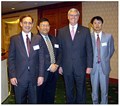U.S. EPA Official Visits China, Pledges Cooperation On Environmental Issues

 Yellow Springs, OH — Stephen L. Johnson, Administrator of United States Environmental Protection Agency (EPA), received a first-hand view of China's environmental challenges during a recent visit in April to the country.
Yellow Springs, OH — Stephen L. Johnson, Administrator of United States Environmental Protection Agency (EPA), received a first-hand view of China's environmental challenges during a recent visit in April to the country.
Johnson has stated that his goal for the EPA is to promote sound science and collaborative approaches to solving environmental problems.
The EPA has been collaborating with its counterpart, China's Environmental Protection Administration (SEPA), on environmental issues for over two decades. In 2003, EPA and SEPA signed a Memorandum of Understanding (MOU) to solidify the organizations' cooperation. The MOU established a working group to coordinate and facilitate the implementation of the Strategy for Clean Air and Energy Cooperation, which tackles issues such as reducing emissions from factories, vehicles, and household appliances. Last month EPA and SEPA added projects to the MOU to deal with hazardous waste disposal.
While on his first-ever visit to China, Johnson met YSI China employees at a "family style" dinner meeting arranged by the Shanghai American Chamber of Commerce. About 15 people from US companies based in Shanghai attended the meeting, plus a similar number of representatives from the EPA, American Consulate, and Shanghai American Chamber of Commerce.
Leo Cho, president of YSI China, had the opportunity to address Johnson during this dinner, sharing his suggestions on how the EPA can help enhance the technical level of water quality monitoring in China. Johnson was also very impressed with YSI's tag line "Pure Data for a Healthy Planet," printed on business cards. He pointed it out to all the meeting attendees during the open discussions that evening.
In an address to students at Beijing University a few days before the dinner, Johnson echoed the sentiments found in YSI's tag line -- outlining the importance of keeping China' water, along with its air, healthy:
EPA and SEPA have expressed a strong interest in adapting some of the water policy tools that have been successful in the United States, such as calculating the total maximum daily load of pollutants allowed to enter a water body, and economic instruments that would address use and discharge equity issues. China's authorities are also looking at ways to use wetlands to augment wastewater treatment and best management practices to reduce agricultural contamination of surface waters, especially from animal waste.This year, the [US] and China plan to collaborate on several areas of water management with a focus on the Huai River. This work will include studies and sharing the lessons we have learned in order to better understand the carrying capacity of water bodies.
YSI's multiparameter water quality sensors, profiling systems, and data retrieval capabilities provide real-time monitoring solutions in China, the US, and locations around the world. These solutions help government officials and municipal managers make important decisions regarding the health and safeguarding of their natural resources.
SOURCE: YSI
